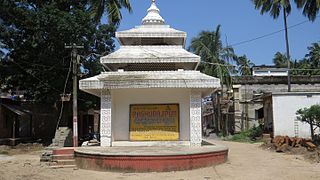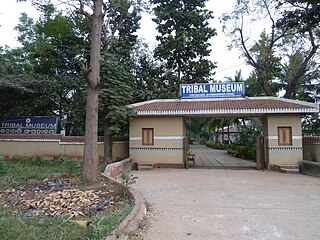
The Indian Museum is a massive museum in Central Kolkata, West Bengal, India. It is the ninth oldest museum in the world and the oldest and largest museum in India as well as in Asia. It has rare collections of antiques, armour and ornaments, fossils, skeletons, mummies and Mughal paintings. It was founded by the Asiatic Society of Bengal in Kolkata (Calcutta), India, in 1814. The founder curator was Nathaniel Wallich, a Danish botanist.

Bhubaneswar is the capital and largest city of the Indian state of Odisha. The region, especially the old town, was historically often depicted as Chakra Kshetra and Ekamra Kshetra. Bhubaneswar is dubbed the "Temple City", a nickname earned because of the 700 temples which once stood there. In contemporary times, it has emerged as an education hub and an attractive business destination.

The Government Museum, Chennai, or the Madras Museum, is a museum of human history and culture located in the Government Museum Complex in the neighbourhood of Egmore in Chennai, India. Started in 1851, it is the second oldest museum in India after the Indian Museum in Kolkata. It is particularly rich in archaeological and numismatic collections. It has the largest collection of Roman antiquities outside Europe. Among them, the colossal Museum Theatre is one of the most impressive. The National Art Gallery is also present in the museum premises. Built in Indo-Saracenic style, it houses rare European and Asian painting of renowned artists, including that of Raja Ravi Varma. It had 0.6 million visitors in 2018. It has the richest collections of bronze idols, 500 of them dating to 1000 BCE, in Asia.

Kalahandi district is a district of Odisha in India. Archaeological evidence of Stone Age and Iron Age human settlement has been recovered from the region. Asurgarh offered an advanced, well civilised, cultured and urban human settlement about 2000 years ago in the region. In South Asia it is believed that the lands of Kalahandi district and Koraput district were the ancient places where people started cultivation of paddy. In ancient time it was known as Mahakantara and Karunda Mandal, which means treasure of precious stones like karandam (corundum/manik), garnet, beruz, neelam, and alexandrite, etc. Manikeswari is the clan deity of Kalahandi may also signify its historical name.

The National Museum in New Delhi, also known as the National Museum of India, is one of the largest museums in India. Established in 1949, it holds a variety of articles ranging from pre-historic era to modern works of art. It functions under the Ministry of Culture, Government of India. The museum is situated on Janpath. The blue–print of the National Museum had been prepared by the Gwyer Committee set up by the Government of India in 1946. The museum has around 200,000 works of art, mostly Indian, but some of foreign origin, covering over 5,000 years.

The Illinois State Museum features the life, land, people and art of the State of Illinois. The headquarters museum is located on Spring and Edwards Streets, one block southwest of the Illinois State Capitol, in Springfield. There are three satellite locations: Dickson Mounds in Lewistown, the Lockport Gallery in Lockport, and the ISM's Research and Collections Center in Springfield.

The Assam State Museum, previously Assam Provincial Museum, is located in the southern end of Dighalipukhuri tank which is in the heart of Guwahati city, Assam. The Museum was established by the Kamarupa Anusandhan Samiti in 1940. The late Kanaklal barua was the founder and president. In the year 1953, it was taken over by the Assam State Government.

Boitas were larger boats and ships that were built in the ancient Kalinga region during its maritime history. Kalinga's sea facing regions consisting of coastal Odisha had major trading ports for which boitas were used. Ancient Sadhabas sailed from Kalinga to distant lands such of Sri Lanka and South-East Asia including both mainland and insular Southeast Asian regions for trade.

The National Mission for Manuscripts (NAMAMI) is an autonomous organisation under Ministry of Culture, Government of India, established to survey, locate and conserve Indian manuscripts, with an aim to create national resource base for manuscripts, for enhancing their access, awareness and use for educational purposes. The Mission was initiated in February 2003, by the Ministry of Tourism and Culture, Government of India and Indira Gandhi National Centre for the Arts (IGNCA) is the nodal agency for the execution of this project. It creates bibliographic databases of Indian manuscripts and is involved in the conservation and preservation of the manuscripts.

Goa State Museum, also known as the State Archaeology Museum, Panaji, is a museum in Goa, India. Established in 1977, it contains departments including Ancient History and Archaeology, Art and Craft, and Geology. The museum, as of 2008, had about 8,000 artifacts on display, including stone sculptures, wooden objects, carvings, bronzes, paintings, manuscripts, rare coins, and anthropological objects. Currently, the Museum is located at the Adil Shah's Palace in Panaji. The Museum's erstwhile premises at the EDC Complex in Patto, Panaji shall be demolished to make way for a new Museum building.

A Sambalpuri sari is a traditional handwoven bandha (ikat) sari wherein the warp and the weft are tie-dyed before weaving. It is produced in the Sambalpur, Balangir, Bargarh, Boudh and Sonepur districts of Odisha, India. The sari is a traditional female garment in the Indian subcontinent consisting of a strip of unstitched cloth ranging from four to nine metres in length that is draped over the body in various styles.

Tribal art is the visual arts and material culture of indigenous peoples. Also known as non-Western art or ethnographic art, or, controversially, primitive art, tribal arts have historically been collected by Western anthropologists, private collectors, and museums, particularly ethnographic and natural history museums. The term "primitive" is criticized as being Eurocentric and pejorative.

Patachitra or Pattachitra is a general term for traditional, cloth-based scroll painting, based in the eastern Indian states of Odisha, West Bengal and parts of Bangladesh. Patachitra artform is known for its intricate details as well as mythological narratives and folktales inscribed in it. Pattachitra is one of the ancient artworks of Odisha, originally created for ritual use and as souvenirs for pilgrims to Puri, as well as other temples in Odisha. Patachitras are a component of an ancient Bengali narrative art, originally serving as a visual device during the performance of a song.

Raghurajpur is a heritage crafts village out of Puri district, India, known for its master Pattachitra painters, an art form which dates back to 5 BC in the region and Gotipua dance troupes, the precursor to the Indian classical dance form of Odissi. It is also known as the birthplace of one of the finest and Legendary Odissi exponents Padma Vibhushan Guru, Kelucharan Mohapatra and Gotipua Dancer Padma Shri Guru, Maguni Charan Das. It is also the birth place of Shilp Guru Dr. Jagannath Mahapatra who is a prominent Pattachitra Artist and has a huge contribution on the development of Pattachitra art and Raghurajpur village. Apart from that, the village is also home to crafts like Tussar paintings, Palm leaf Engravings, Stone carvings, Wood carvings, Cowdung toys and Papier mache toys, and masks.

Kailash Chandra Meher is an Indian artist, inventor, and social activist. He is a painter of contemporary modern art paintings and traditional Tussar Pattachitra paintings of Odisha. He was a recipient of the Padma Shri by the Government of India in 2013.

Tribal Research Institute Museum, Museum of Tribal Arts and Artifacts, is a museum in Bhubaneswar, Odisha inside the campus of Scheduled Castes & Scheduled Tribes Research & Training Institute. It is popularly known as Tribal Museum and conceptually labeled as Museum of Man. It has life-sized authentic tribal dwellings, created by the tribal craftsmen offers a view of the State's tribal heritage. It has sections which showcase tribal artifacts and objects, focusing on well researched, documented cultural life of tribals of Odisha. It is headed by a Director, who is in the rank of a University Professor, and the administrative control lies in the hands of ST, SC, Minorities, and Backward Classes Welfare Department, Government of Odisha.

Bharat Kala Bhavan is a university museum located in Banaras Hindu University, Varanasi, India. It has been instrumental in the dissemination of knowledge on Indian art and culture. It is one of the important touristic attractions in the Banaras Hindu University and in the city of Varanasi.
Clara Lee Tanner was an American anthropologist, editor and art historian. She is known for studies of the arts and crafts of American Indians of the Southwest.

Dinanath Pathy was an Indian painter, author and art historian from the state of Odisha. Pathy was the former secretary of Lalit Kala Akademi in New Delhi and Bhubaneswar. He was the founding principal of the B.K. College of Art and Crafts. Pathy was awarded the President of India Silver Plaque for painting, Odisha Sahitya Academy Award for autobiography "Digapahandira Drawing Master", and Jawaharlal Nehru Fellowship for his research in art. He was nominated for the International Rietberg Award from Rietberg Society in 2014 for his contributions to research on Indian art history. Pathy authored over 50 books in English, Odia and German on classical, traditional, tribal, folk, rural and contemporary art of Odisha.

Odisha Crafts Museum also known as Kalabhoomi is a museum in Bhubaneswar, Odisha, India, dedicated to the art and crafts of Odisha. It was inaugurated by the Chief Minister of Odisha, Naveen Patnaik, on 22 March 2018. The museum is spread across 12.68 Acres of an area, divided into eight galleries, Open air amphitheater, workshop area and souvenir shop.






















